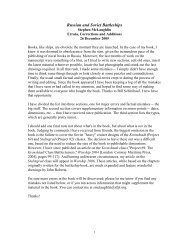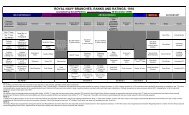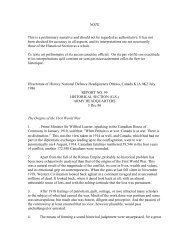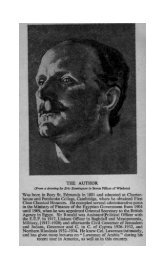THE SCHLIEFFEN PLAN - The World War I Document Archive
THE SCHLIEFFEN PLAN - The World War I Document Archive
THE SCHLIEFFEN PLAN - The World War I Document Archive
Create successful ePaper yourself
Turn your PDF publications into a flip-book with our unique Google optimized e-Paper software.
<strong>THE</strong> MILITARY TESTAMENT OF<br />
63<br />
IQ05<br />
army corps are most needed on, or behind, the right army wing." But<br />
how to get them there in time, i.e. by rail? As we know, the Belgian<br />
railways were completely destroyed in the Belgian retreat of 1914.<br />
For many weeks the right army could only be reached by marching<br />
and would have been without supplies had the Supreme Command<br />
not given it almost the entire stock ot lorries. 40 Schlicffen was very<br />
uncertain on this point. We saw earlier how poorly he rated the<br />
efficiency of the French and Belgian railways during the first weeks of<br />
war. In the earlier drafts two army corps were the most he expected to<br />
transport from the left to the right wing. In the final version the<br />
question of the railways' capacity is left open. Anything they cannot move<br />
will have to be used on the Meuse, at Metz, or "right of the Moselle."<br />
But how does this tally with the simultaneous statement that no less<br />
than six "new army corps" are needed for the cordon west and south-<br />
east of Paris? Schlicffcn's Nachlass provides no answer. Is it surprising<br />
that in 1914 Moltke preferred to dispense with the western envelop-<br />
ment ot Paris? It may also have been made easier for him by the fact<br />
that there was no longer the immediate threat of a British flank attack<br />
from the Channel ports, which Schlieffen, in 1905, was still expecting,<br />
without being able to suggest an effective counter-measure. 41<br />
But these considerations have not touched the really vital danger:<br />
that the enemy might counter the great envelopment with the most<br />
obvious move of all—the rapid extension of his left wing and perhaps<br />
the envelopment of the attacker himself. <strong>The</strong> radial French railway<br />
system with the fortress of Paris as its centre offered every opportunity.<br />
Troops could be switched from one part of the front to another at very<br />
great speed, while the woods surrounding Paris made it possible to<br />
mass troops unnoticed for a counter-attack on the German right wing.<br />
Would not the inevitable consequence be a race for the sea in which<br />
the Germans with their inferior railway connections would ultimately<br />
be at a disadvantage? As we know, in September 1914 the sudden<br />
appearance of the strong French army under Maunoury on the west<br />
flank of the German right whig-army wrecked the whole plan of<br />
campaign, because the Supreme Command considered, rightly or<br />
wrongly, that it had not enough reserves both to fight off this army<br />
tactically (which was done, at great sacrifice, on the Ourcq) and also to<br />
eliminate it strategically by further outflanking, so as permanently<br />
to secure the German right flank.<br />
40 Ta ppen, Bis zitr Marne 1914(1920), pp. 7,I4et. al. 41 Cf. his footnote, p. 142, below.









